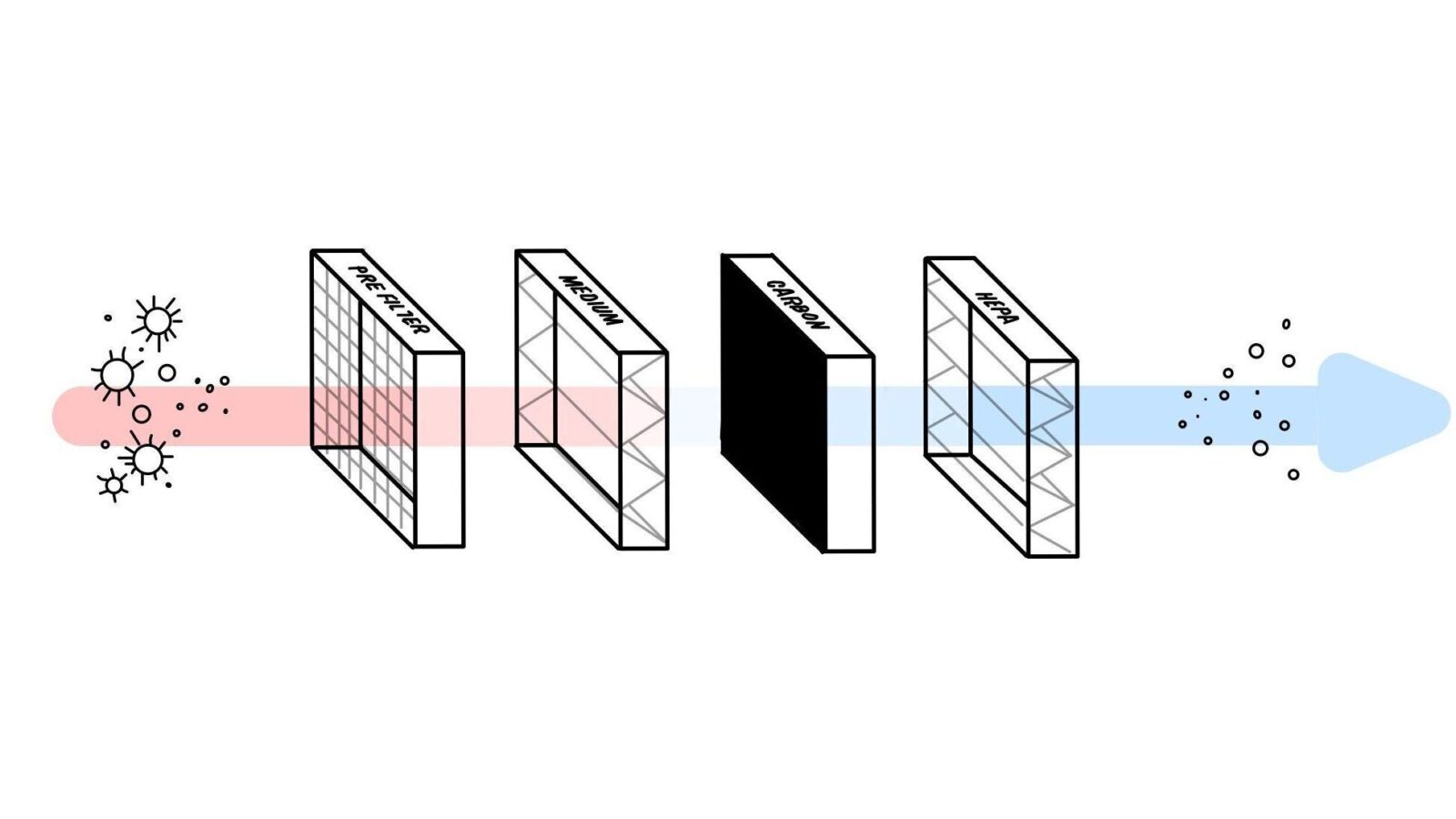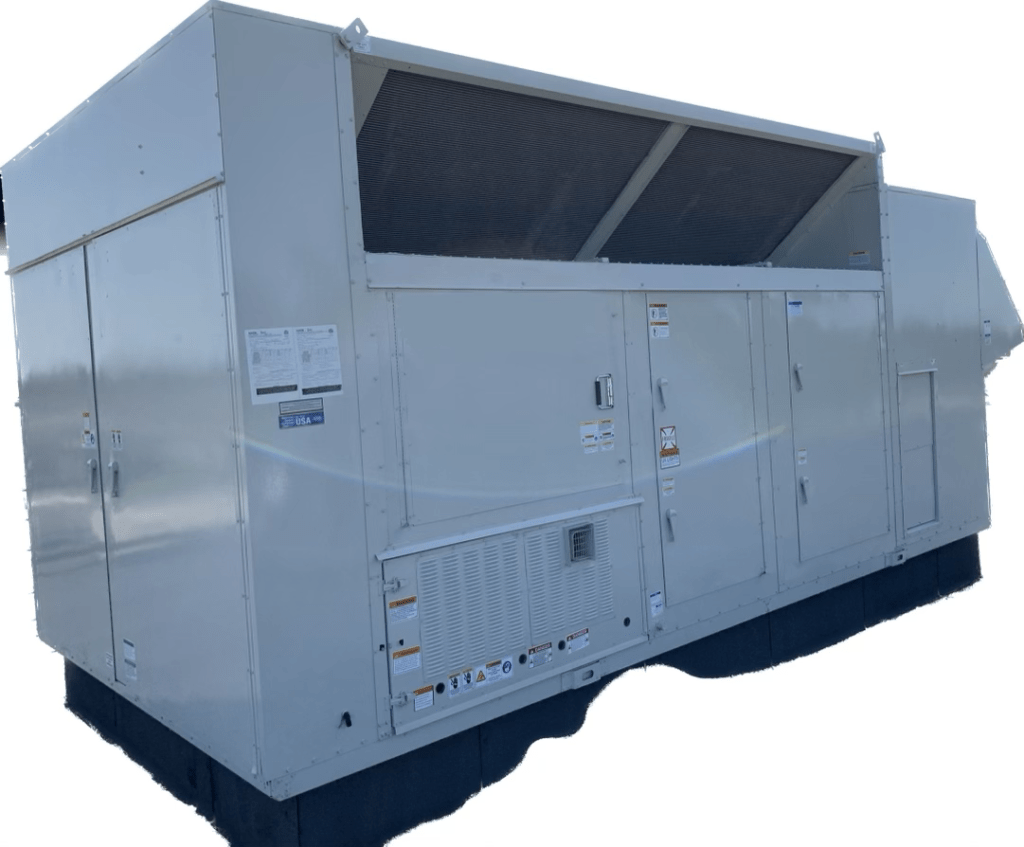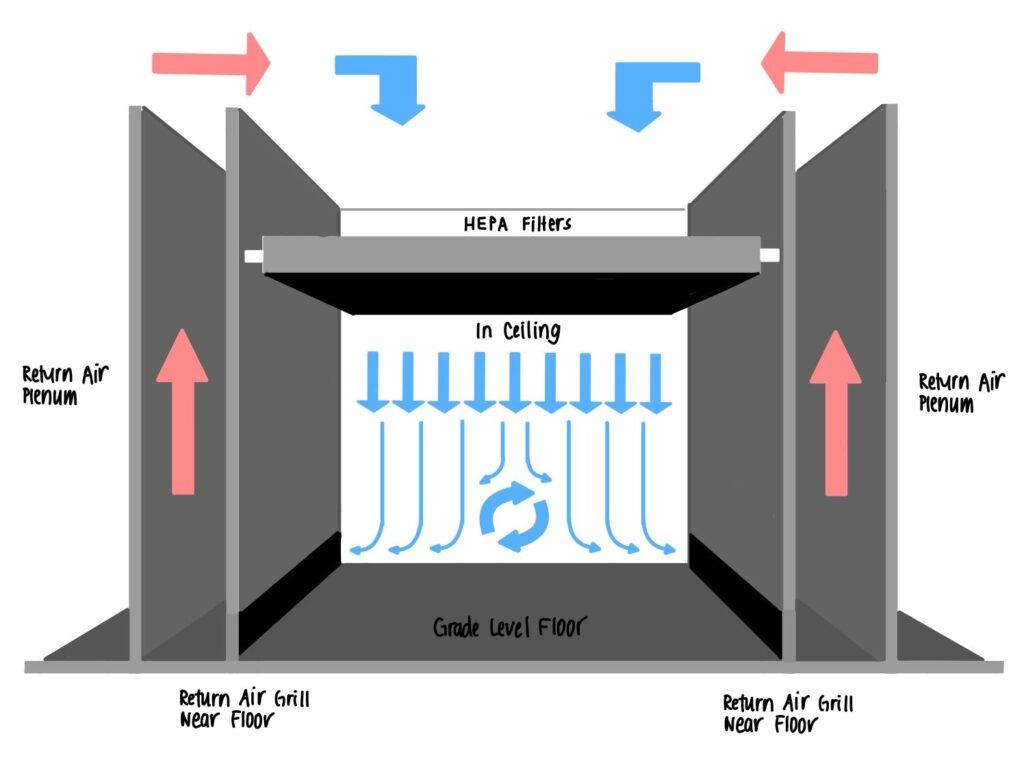What are HVAC Systems?

HVAC (heating, ventilation, and air conditioning) systems play a critical role in maintaining proper conditions within a cleanroom. The design of the HVAC system is a crucial factor in ensuring that the cleanroom meets necessary standards for cleanliness, temperature, humidity, and pressure.
HVAC Systems in the Cleanroom
The key components of an HVAC system for a clean room are the air filtration system, air flow system, temperature and humidity control, and the use of several types of barriers to minimize the risk of contamination.
One of the key components of an HVAC system for a cleanroom is the air filtration system. The air filtration system is responsible for removing particles, microorganisms, and other contaminants from the air within the clean room. The most common types of air filters used in clean rooms are HEPA (high-efficiency particulate air) filters and ULPA (ultra-low particulate air) filters. These filters can remove particles as small as 0.3 microns, which is much smaller than the size of most particles that can be seen with the naked eye.

Another key component of an HVAC system for a clean room is the air flow system. The air flow system is responsible for maintaining a constant flow of filtered air throughout the clean room. This is typically accomplished by using a series of supply and exhaust air ducts, as well as air diffusers and grilles. The design of the air flow system is critical in ensuring that the clean room can maintain the necessary levels of cleanliness.
Temperature and humidity control are also important components of the HVAC system. A clean room must be maintained within a specific temperature and humidity range to ensure that the conditions are suitable for the work being done. This is typically accomplished by using a combination of heating, cooling, and humidification/dehumidification equipment.
The HVAC system must also be designed to minimize the risk of contamination by using several types of barriers, such as HEPA-filtered air locks, to separate the clean room from the surrounding environment.
Temperature Control
Temperature can be controlled in a cleanroom using a variety of methods and equipment. Some of the most common methods for controlling temperature include:
- Heating Systems: Air Handling Unit (AHU) is used to maintain temperature in the Cleanroom. Boilers or electric heaters, provide heat to the AHU coils to increase the temperature.
- Cooling Systems: These systems, such as air conditioners or chilled water systems, remove heat from the cleanroom to decrease the temperature. They can be used to maintain a specific temperature within the cleanroom.
- Temperature Sensors: These devices measure the temperature within the cleanroom and send a signal to the heating or cooling systems to adjust the temperature as needed.
- Temperature Control Systems: These systems use a combination of heating, cooling, and temperature sensors to control the temperature within the cleanroom. They can be programmed to maintain a specific temperature and can automatically adjust the temperature as needed.
- Insulation: Proper insulation of the cleanroom can also help to maintain a consistent temperature.

Humidity Control
Humidity can be controlled in a cleanroom using a variety of methods and equipment. Some of the most common methods for controlling humidity include:
- Humidifiers: These devices add moisture to the air within the cleanroom to increase the humidity level. They can be used to maintain a specific humidity level within the cleanroom.
- Dehumidifiers: These devices remove moisture from the air within the cleanroom to decrease the humidity level. They can be used to maintain a specific humidity level within the cleanroom.
- Humidity Sensors: These devices measure the humidity level within the cleanroom and send a signal to the humidifiers or dehumidifiers to adjust the humidity level as needed.
- Humidity Control Systems: These systems use a combination of humidifiers, dehumidifiers, and humidity sensors to control the humidity level within the cleanroom. They can be programmed to maintain a specific humidity level and can automatically adjust the humidity as needed.
- Air Conditioning Units: These units can also be used to control humidity by adjusting the temperature and air flow.
- Desiccant Dehumidifiers: These dehumidifiers use a desiccant material, such as silica gel, which absorbs moisture from the air. They are particularly useful in environments where low humidity is required, and the temperature is low.
Pressure Control
Pressure control in a cleanroom is important because it helps to maintain the proper airflow and prevent contaminants from entering or exiting the room. There are several methods for controlling pressure in a cleanroom, including:
- Positive Pressure: This method involves maintaining a higher pressure inside the cleanroom than outside, which helps to prevent contaminants from entering the room. This is achieved by using a combination of supply and exhaust air ducts, as well as air diffusers and grilles, to maintain a constant flow of filtered air throughout the cleanroom.
- Negative Pressure: This method involves maintaining a lower pressure inside the cleanroom than outside, which helps to prevent contaminants from exiting the room. This is achieved by using a combination of supply and exhaust air ducts, as well as air diffusers and grilles, to maintain a constant flow of filtered air throughout the cleanroom.
- Constant Airflow: This method involves maintaining a constant flow of air throughout the cleanroom to help control the pressure. This is achieved by using a combination of supply and exhaust air ducts, as well as air diffusers and grilles.
- Pressure Sensors: These devices measure the pressure within the cleanroom and send a signal to the air handling unit to adjust the pressure as needed.
- Pressure Control Systems: These systems use a combination of pressure sensors, air handling units, and ducting to control the pressure within the cleanroom. They can be programmed to maintain a specific pressure and can automatically adjust the pressure as needed.
It is important to note that the temperature, humidity and pressure control methods used should depend on the specific requirements of the cleanroom, such as the type of work being done, the layout of the room, and the potential sources of contamination.

Cleanliness Control
Cleanliness can be controlled in a cleanroom using the HVAC system by implementing several key elements:
- Air Filtration: The HVAC system should include high-efficiency air filters such as HEPA (high-efficiency particulate air) or ULPA (ultra-low particulate air) filters, which can remove particles as small as 0.3 microns, which is much smaller than the size of most particles that can be seen with the naked eye. This helps to remove contaminants from the air inside the cleanroom.
- Air Flow Control: The HVAC system should include a system of supply and exhaust air ducts, as well as air diffusers and grilles, which maintain a constant flow of filtered air throughout the cleanroom. This helps to prevent the buildup of contaminants and maintain a consistent level of cleanliness.
- Temperature and Humidity Control: Temperature and humidity are crucial factors that affect the growth of microorganisms and the behavior of particles. By controlling these factors, the HVAC system can help to prevent the growth of microorganisms and minimize the movement of particles.
- Barrier Systems: The HVAC system should include several types of barriers such as HEPA-filtered air locks, which help to separate the cleanroom from the surrounding environment, minimizing the risk of contamination.
- Monitoring and Maintenance: Regular monitoring and maintenance of the HVAC system is important to ensure that it is functioning correctly, and that the cleanroom is maintained at the required level of cleanliness. This includes regular cleaning and replacement of air filters, calibration of sensors and monitoring devices, and regular inspections of the overall system.
To maintain air quality and temperature, it is important to use the right components such as dampers, terminal HEPA filters, insulation, and maintaining the static pressure. By implementing these key elements, the HVAC system can help to control the cleanliness of the cleanroom environment, ensuring that it meets the necessary standards for cleanliness, temperature, and humidity.
HVAC Ducting
Ducting is a vital component of an HVAC system as it is responsible for the distribution of conditioned air throughout the cleanroom. Ducting plays a critical role in maintaining the desired temperature, humidity, and air quality within the cleanroom. It is important to note that ducting can be a source of contamination if not professionally designed and maintained.
Some of the reasons why ducting is important for HVAC performance include:
- Air Distribution: Ducting is responsible for the distribution of conditioned air throughout the cleanroom. It allows the HVAC system to control the temperature and humidity levels within the cleanroom by moving the conditioned air to where it is needed.
- Air Flow Control: Ducting is used to control the flow of air throughout the cleanroom. This helps to maintain a consistent level of air quality and prevent the buildup of contaminants.
- Pressure Control: Ducting is used to control the pressure within the cleanroom. By maintaining a consistent pressure, ducting helps to prevent the infiltration of contaminants from outside the cleanroom, as well as the exfiltration of contaminants from inside the cleanroom.
- Energy Efficiency: Ducting can help to improve the energy efficiency of an HVAC system. By professionally designing and sealing the ducts, the HVAC system can operate more efficiently, reducing the energy consumption and costs.
- Noise Reduction: Ducting can help to reduce the noise generated by the HVAC system. By intelligently designing and insulating the ducts, the HVAC system can operate more quietly, reducing the noise level within the cleanroom.
- Insulation: Insulation is used to reduce the heat loss or gain through the ducts. It helps to maintain the desired temperature and reduce energy consumptions. It is typically made of fiberglass or mineral works and is installed on the exteriors of ductwork.
A professionally designed HVAC system with all associated controls and ducting is essential for maintaining desired air quality and temperature in a cleanroom. Proper installation and maintenance of the ducting are also important to ensure that the system is operating at peak efficiency.
Commercial HVAC System vs Cleanroom HVAC System
While they both provide heating, ventilation, and air conditioning to a facility, commercial and cleanroom HVAC systems have several key differences.
| COMMERCIAL | CLEANROOM | |
|---|---|---|
| Air Filtration | Air filters can remove larger particles, such as dust and pollen from the air. These filters are designed to improve the air quality within the building, but are not able to remove particles as small as 0.3 microns. | Cleanrooms use air filters such as HEPA (high-efficiency particulate air) and ULPA (ultra-low particulate air) filters which can remove particles as small as 0.3 microns. This level of filtration is necessary to maintain the necessary levels of cleanliness within the clean room. |
| Air Flow Control | Designed to provide a comfortable environment for the occupants of the building, but they do not typically require a constant flow of filtered air throughout the building. | Cleanroom HVAC systems use a series of supply and exhaust air ducts, as well as air diffusers and grilles, to maintain a constant flow of filtered air throughout the clean room. This is necessary to ensure that the clean room can maintain the necessary levels of cleanliness. |
| Temperature and Humidity Control | Commercial HVAC systems are designed to provide a comfortable environment for building occupants. | Cleanrooms require a specific range of temperature and humidity to be maintained to ensure that the conditions are suitable for the work being done. The HVAC systems in cleanrooms are designed to maintain this specific range and to minimize the risk of contamination. |
In conclusion, the HVAC is an essential component of the cleanroom, requiring strict control of airborne particles, temperature, and humidity. It is important to work with an experienced HVAC professional to ensure that the HVAC system is designed and maintained correctly to meet the specific needs of the cleanroom.
GET IN TOUCH
Complete the form below to get in touch with our team.
